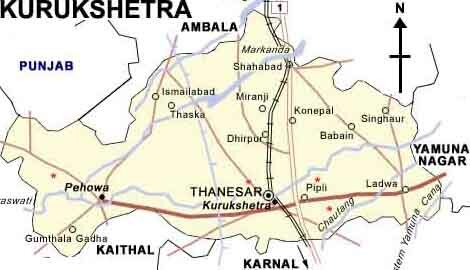
Information about Kurukshetra
Kurukshetra is a small town and the modern temple here can be described as Kitsch, an artificial reproduction of earlier temple styles. But the site is important for its influence on the development of Hindi ideas, not Hindu architecture. Modern Kurukshetra has no trace of the period when it played the central role described in the Mahabharata as the battlefield where Arjuna learned the meaning of dharma. The flat plain around Kurukshetra is described in Sanskrit literature as Brahmavarta (land of the Sages) and is regarded as particularly sacred.
Kurukshetra town is situated 160 km north of Delhi on the national highway NH1. Other towns of the district are Pehowa, Ladwa, Ismailabad and Shahabad. The total area of Kurukshetra district is 1,682 sq kms and its population is 6,41,000. Total area under cultivation is 1,68,000 hectares out of this, 1,47,000 is irrigated area. The Kurukshetra district lies between latitude 29o-52' to 30o- 12' and longitude 76o-26' to 77o-04' in the North Eastern part of Haryana State. The district has a total of 419 villages. Ghaggar, Markanda and Saraswati are the important rivers of the district.
Geography: The district is a plain which slopes generally from North East to South West. The plain is remarkable flat and within it, are the narrow low-lying flood plains, known as either Betre Khadar of Naili. A good network of canals is providing irrigational facilities. Underground water level is not relatively high. Tube well irrigation is also common in the district. It is one of the prosperous district from agriculture point of view. Kurukshetra along with Karnal and Kaithal districts is known as the 'Rice Bowl of India' and famous for Basmati Rice. The soil is generally alluvial, loam and clay does not constitute average texture of the soil.
Climate of the district is very hot in summer (upto 47° C) and cold in winter (down to 1° C) with rains in July and August.
Kurukshetra is a place of great historical and religious importance, revered all over the country for its sacred association with the Vedas and the Vedic Culture. It was here that the battle of Mahabharat was fought and Lord Krishna preached his Philosophy of 'KARMA' as enshrined in the Holy Bhagwad-Gita, to Arjuna at Jyotisar. In the very first verse of Bhagwad-Gita, Kurukshetra is described as DHARAMKSHETRA i.e. 'Region of righteousness'. According to Hindu mythology, the name Kurukshetra applied to a circuit of about 48 KOS or about 128 Km which includes a large number of holy places, temples and tanks connected with the ancient Indian traditions and the Mahabharat War and Kurus, the ancestor of Kouravs and Pandavs. Kurukshetra is intimately related to the Aryan civilization and its growth along the Saraswati river. Places to visit: There are about 360 Tirthas of religious and historic importance. The foremoót among the Kurukshetra tirthas are Brahmsarovar or Kurukshetra Tank, Sannihit Tank, Sthanesvra Mahadev Mandir, Jyotisar, Baan-ganga, Bhisam Kund (Narkatari) Chandrakupa, Nabhi Kamal, Bhadarkali Mandir, Arnai Temple, Prachi Tirath Pehowa, Saraswati Tirath Pehowa, Prithduk Tirath Pehowa, Rantuk Yaksh Bir pipli, Karan Ka Tila,etc.
Places to visit: There are about 360 Tirthas of religious and historic importance. The foremoót among the Kurukshetra tirthas are Brahmsarovar or Kurukshetra Tank, Sannihit Tank, Sthanesvra Mahadev Mandir, Jyotisar, Baan-ganga, Bhisam Kund (Narkatari) Chandrakupa, Nabhi Kamal, Bhadarkali Mandir, Arnai Temple, Prachi Tirath Pehowa, Saraswati Tirath Pehowa, Prithduk Tirath Pehowa, Rantuk Yaksh Bir pipli, Karan Ka Tila,etc.
A few archaeological sites which have yielded various objects of interest and a distinctive class of pottery known as the Painted Grey Ware (PGW) are Raja Karan Ka Tila, Asthipura, Bhor Saidan, Bhagpura and Daulatpur.
Kurukshetra is one of the very few places visited by all the Sikh Gurus and Gurdwaras have been erected to commemorate their visit, the most prominent among them being the Gurdwara Patshahi dedicated to the sixth Guru Hargobind. Hundreds of devotees visit this shrine every day whose design is simply marvelous. The eighth Sikh guru Harkishan performed a miracle of making a deaf and dumb boy recite verses from the Bhagvad-Gita. The ninth Guru, Teg Bahadur, set camp near Sthaneshwar tirtha where a gurdwara now stands. Gurdwara Rajghat, the biggest all the Kurukshetra gurdwaras, is located near the main bank of the Kurukshetra tank. This was built in the memory of the Guru Gobind Singh who came here.
Tomb of Sufi saint Sheikh Chilhi Jalal is a fascinating monument, octagonal in shape, crowned with a dome of white marble and surrounded by a white marble courtyard. Also worth a visit are, Chini Masjid and Pathar Masjid.
| ||||||||||||||||
| | ||||||||||||||||
|
No comments:
Post a Comment